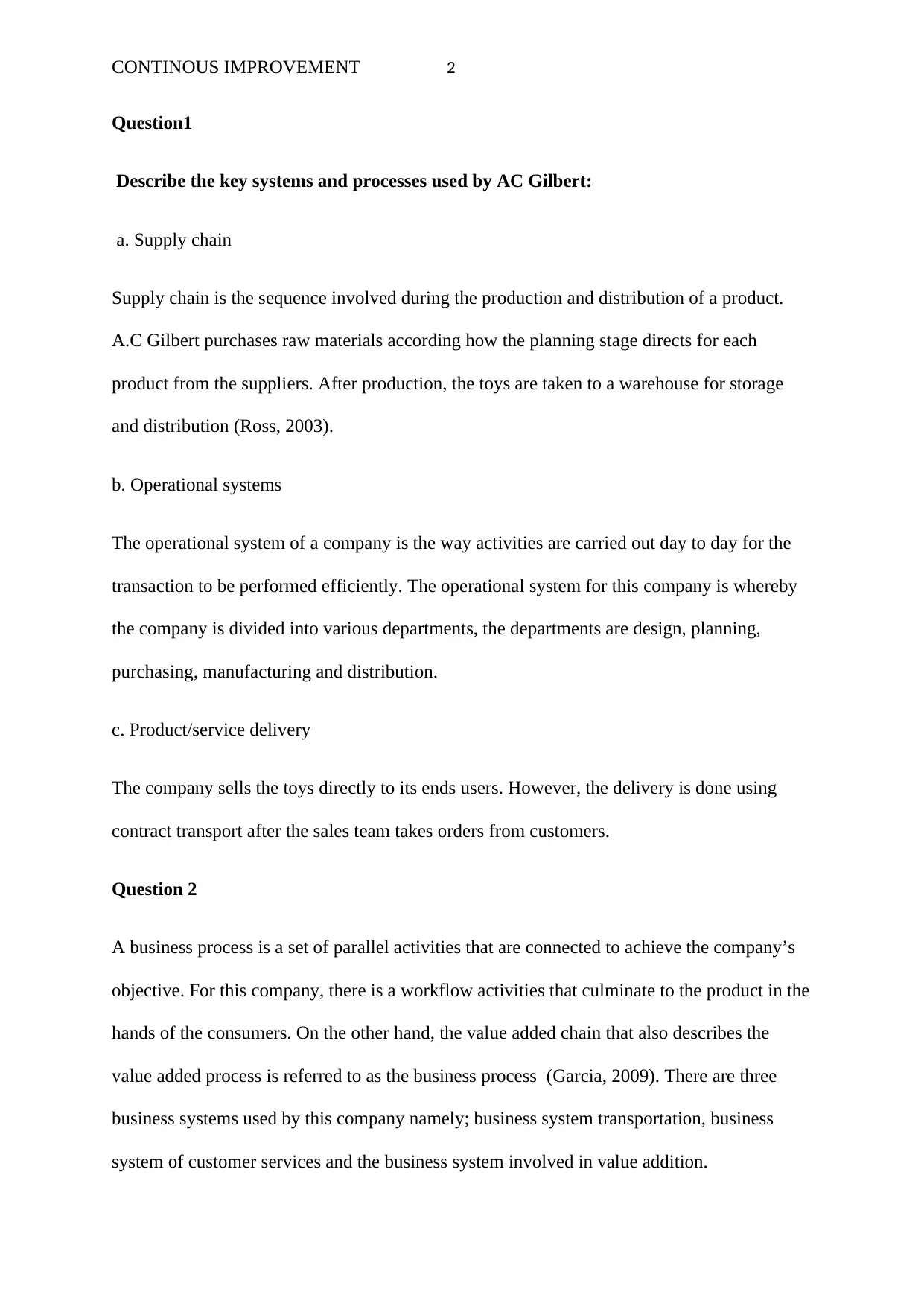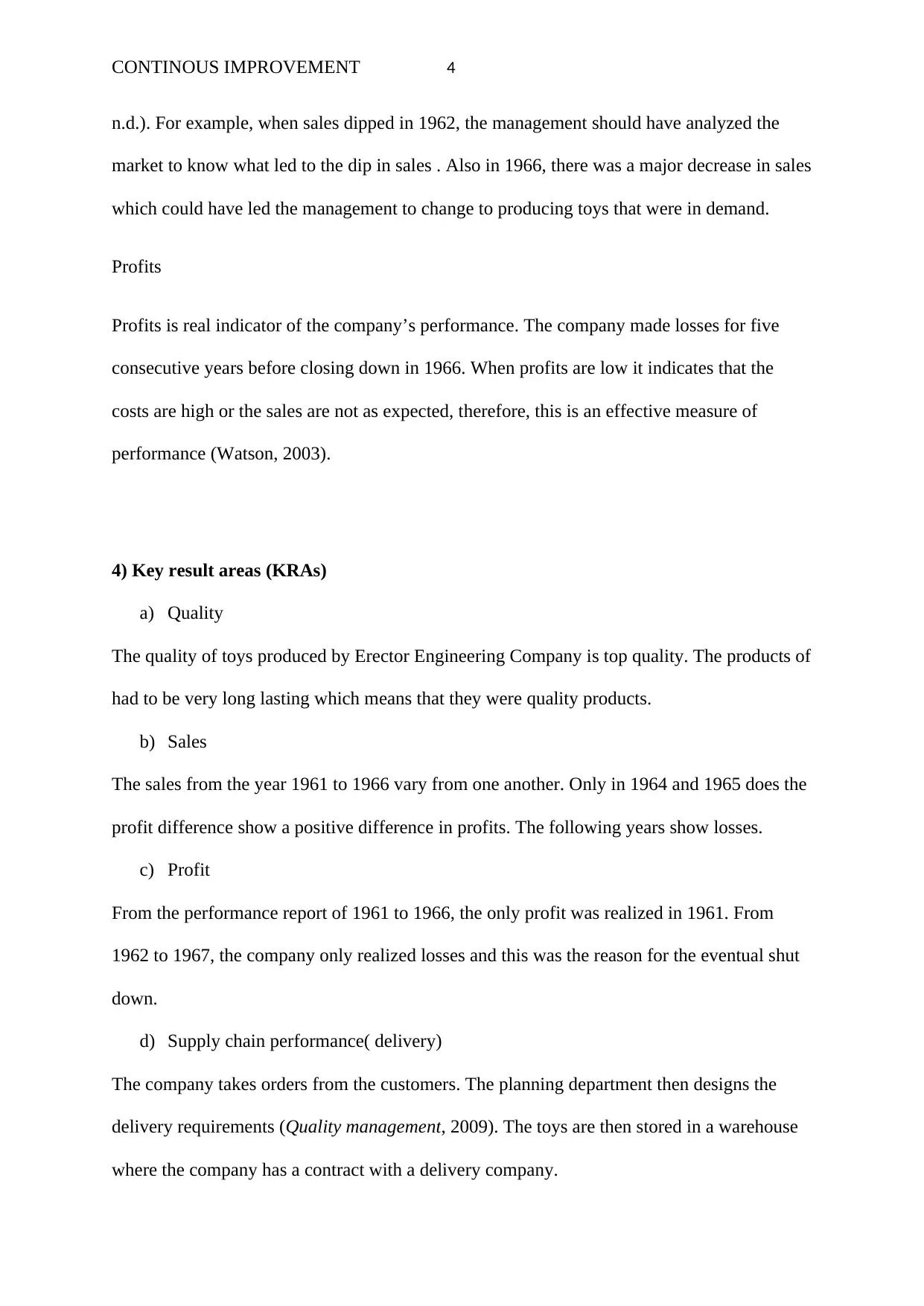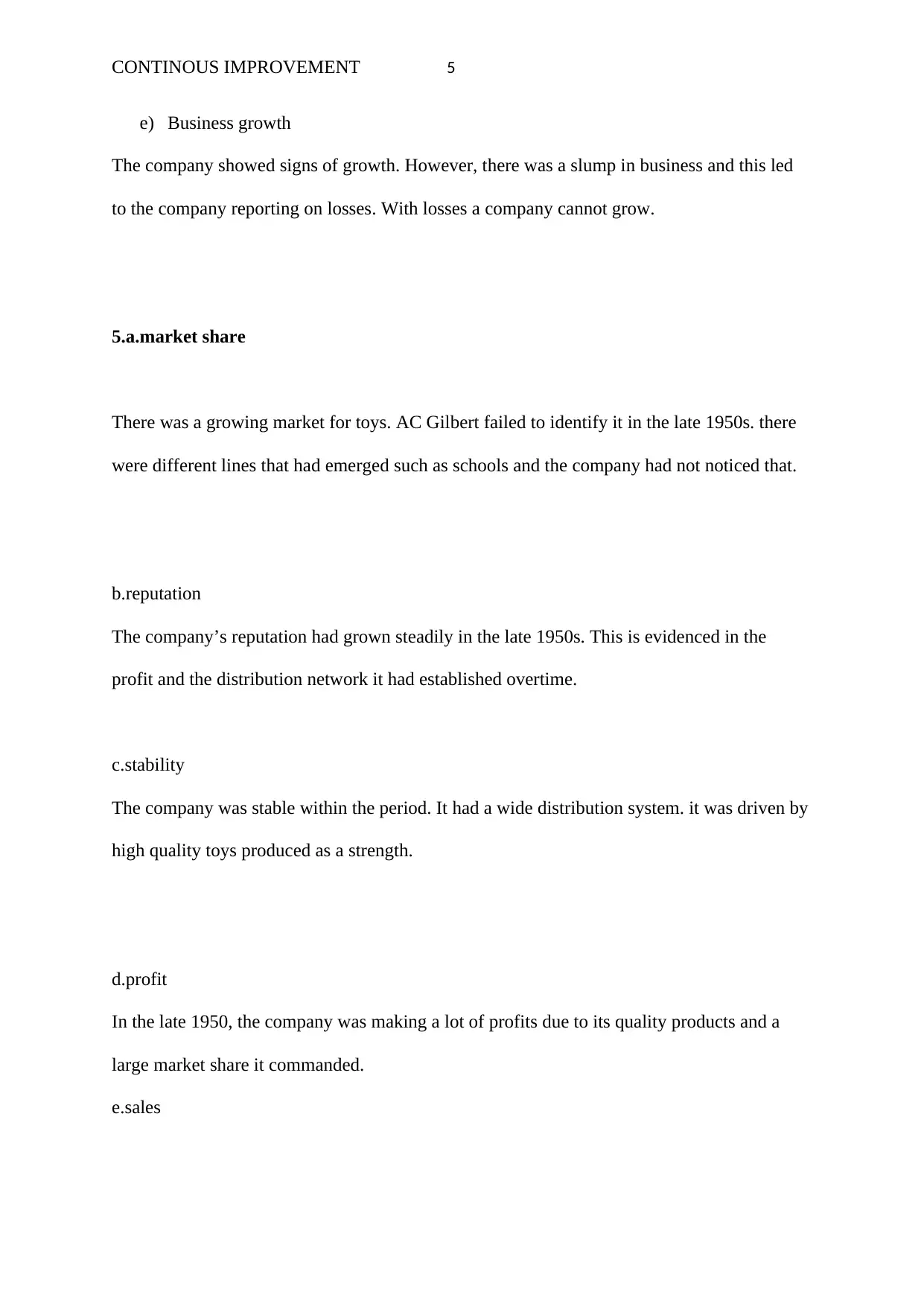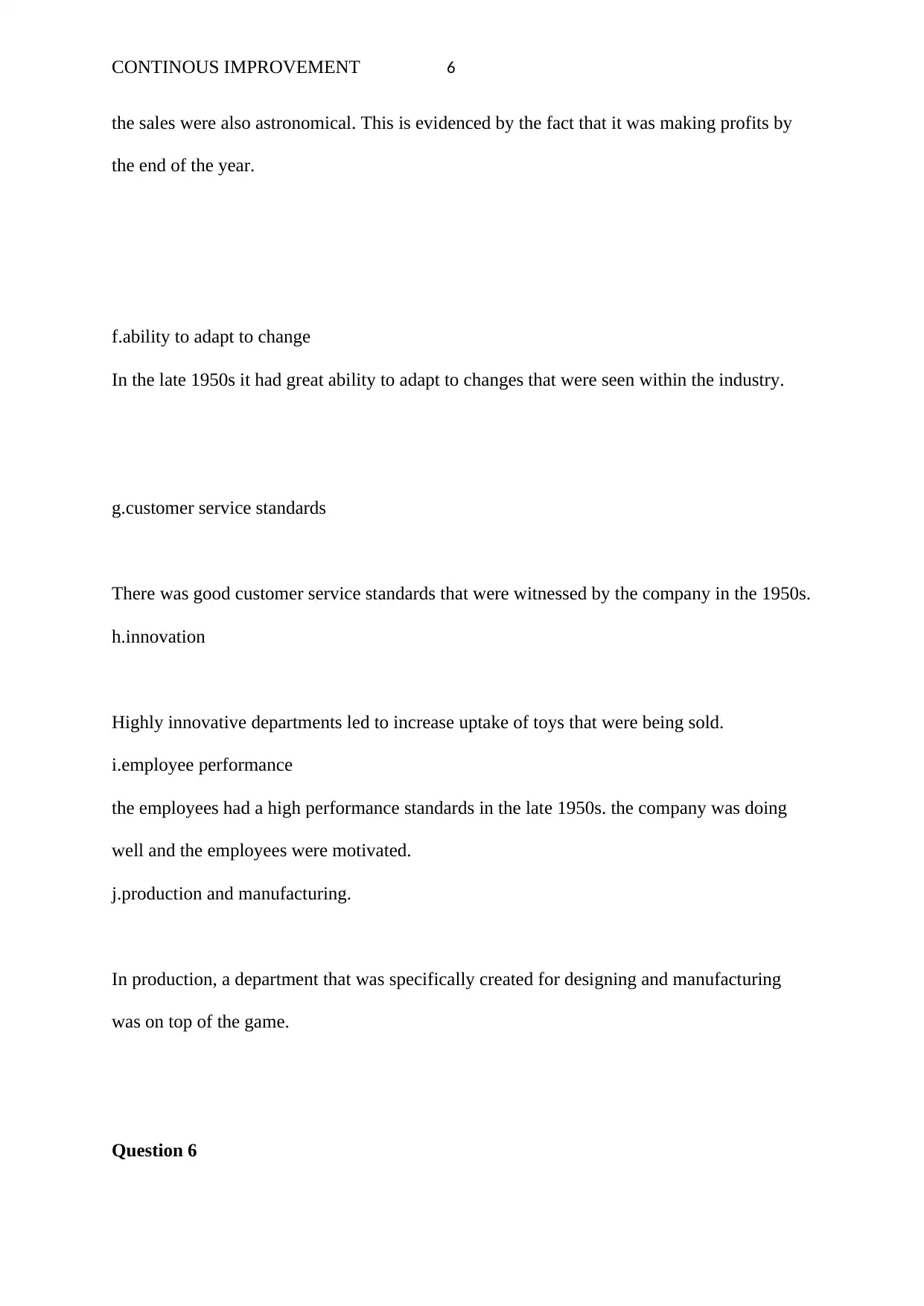Comprehensive Report: AC Gilbert Company's Performance Analysis
VerifiedAdded on 2020/04/13
|9
|1206
|474
Report
AI Summary
This report provides a comprehensive analysis of AC Gilbert, examining its key systems and processes, including supply chain, operational systems, and product/service delivery. It identifies the business processes used by the company, key result areas (KRAs), and key performance indicators (KPIs), along with a description of performance review processes and a sample service level agreement. The report also discusses the company's performance monitoring methods, such as sales and profit analysis, and evaluates key result areas like quality, sales, profit, supply chain performance, and business growth. Additionally, the report analyzes factors such as market share, reputation, stability, and the company's ability to adapt to change, customer service standards, innovation, employee performance, and production. Finally, it explores both internal and external factors that may have influenced the company's performance, offering a holistic view of AC Gilbert's business operations and eventual closure.

Running head: CONTINOUS IMPROVEMENT
1
Continous Improvement
Name:
Institution:
Date:
1
Continous Improvement
Name:
Institution:
Date:
Paraphrase This Document
Need a fresh take? Get an instant paraphrase of this document with our AI Paraphraser

CONTINOUS IMPROVEMENT 2
Question1
Describe the key systems and processes used by AC Gilbert:
a. Supply chain
Supply chain is the sequence involved during the production and distribution of a product.
A.C Gilbert purchases raw materials according how the planning stage directs for each
product from the suppliers. After production, the toys are taken to a warehouse for storage
and distribution (Ross, 2003).
b. Operational systems
The operational system of a company is the way activities are carried out day to day for the
transaction to be performed efficiently. The operational system for this company is whereby
the company is divided into various departments, the departments are design, planning,
purchasing, manufacturing and distribution.
c. Product/service delivery
The company sells the toys directly to its ends users. However, the delivery is done using
contract transport after the sales team takes orders from customers.
Question 2
A business process is a set of parallel activities that are connected to achieve the company’s
objective. For this company, there is a workflow activities that culminate to the product in the
hands of the consumers. On the other hand, the value added chain that also describes the
value added process is referred to as the business process (Garcia, 2009). There are three
business systems used by this company namely; business system transportation, business
system of customer services and the business system involved in value addition.
Question1
Describe the key systems and processes used by AC Gilbert:
a. Supply chain
Supply chain is the sequence involved during the production and distribution of a product.
A.C Gilbert purchases raw materials according how the planning stage directs for each
product from the suppliers. After production, the toys are taken to a warehouse for storage
and distribution (Ross, 2003).
b. Operational systems
The operational system of a company is the way activities are carried out day to day for the
transaction to be performed efficiently. The operational system for this company is whereby
the company is divided into various departments, the departments are design, planning,
purchasing, manufacturing and distribution.
c. Product/service delivery
The company sells the toys directly to its ends users. However, the delivery is done using
contract transport after the sales team takes orders from customers.
Question 2
A business process is a set of parallel activities that are connected to achieve the company’s
objective. For this company, there is a workflow activities that culminate to the product in the
hands of the consumers. On the other hand, the value added chain that also describes the
value added process is referred to as the business process (Garcia, 2009). There are three
business systems used by this company namely; business system transportation, business
system of customer services and the business system involved in value addition.

CONTINOUS IMPROVEMENT 3
a. Lists of key result areas (KRAs)
Customer satisfaction
Economic gain
Product quality
Organizational development
Innovation
b. Lists of key performance indicators (KPIs)
Percentage savings in costs
Sales and revenues
Percentage savings in transportation costs
Quality improvement
profit
c. A description of performance review processes
the performance review process of a company includes setting company’s goals and tracking
KPIs on a regular basis.
c. A sample service level agreement.
A contract between the customer and the seller that defines the expected level of standards
that the seller is required to meet. In this case, the contract should specify the following
metrics; Availability of goods, quality of the toys and the service required (Gitlow, 2008).
Question 3
One of the ways to monitor performance is by using sales
When monitoring performance using sales, it is easy to know who the flaws are and how to
prevent potential problems and errors of the company (Baum, Mshvidobadze & Posadas,
a. Lists of key result areas (KRAs)
Customer satisfaction
Economic gain
Product quality
Organizational development
Innovation
b. Lists of key performance indicators (KPIs)
Percentage savings in costs
Sales and revenues
Percentage savings in transportation costs
Quality improvement
profit
c. A description of performance review processes
the performance review process of a company includes setting company’s goals and tracking
KPIs on a regular basis.
c. A sample service level agreement.
A contract between the customer and the seller that defines the expected level of standards
that the seller is required to meet. In this case, the contract should specify the following
metrics; Availability of goods, quality of the toys and the service required (Gitlow, 2008).
Question 3
One of the ways to monitor performance is by using sales
When monitoring performance using sales, it is easy to know who the flaws are and how to
prevent potential problems and errors of the company (Baum, Mshvidobadze & Posadas,
⊘ This is a preview!⊘
Do you want full access?
Subscribe today to unlock all pages.

Trusted by 1+ million students worldwide

CONTINOUS IMPROVEMENT 4
n.d.). For example, when sales dipped in 1962, the management should have analyzed the
market to know what led to the dip in sales . Also in 1966, there was a major decrease in sales
which could have led the management to change to producing toys that were in demand.
Profits
Profits is real indicator of the company’s performance. The company made losses for five
consecutive years before closing down in 1966. When profits are low it indicates that the
costs are high or the sales are not as expected, therefore, this is an effective measure of
performance (Watson, 2003).
4) Key result areas (KRAs)
a) Quality
The quality of toys produced by Erector Engineering Company is top quality. The products of
had to be very long lasting which means that they were quality products.
b) Sales
The sales from the year 1961 to 1966 vary from one another. Only in 1964 and 1965 does the
profit difference show a positive difference in profits. The following years show losses.
c) Profit
From the performance report of 1961 to 1966, the only profit was realized in 1961. From
1962 to 1967, the company only realized losses and this was the reason for the eventual shut
down.
d) Supply chain performance( delivery)
The company takes orders from the customers. The planning department then designs the
delivery requirements (Quality management, 2009). The toys are then stored in a warehouse
where the company has a contract with a delivery company.
n.d.). For example, when sales dipped in 1962, the management should have analyzed the
market to know what led to the dip in sales . Also in 1966, there was a major decrease in sales
which could have led the management to change to producing toys that were in demand.
Profits
Profits is real indicator of the company’s performance. The company made losses for five
consecutive years before closing down in 1966. When profits are low it indicates that the
costs are high or the sales are not as expected, therefore, this is an effective measure of
performance (Watson, 2003).
4) Key result areas (KRAs)
a) Quality
The quality of toys produced by Erector Engineering Company is top quality. The products of
had to be very long lasting which means that they were quality products.
b) Sales
The sales from the year 1961 to 1966 vary from one another. Only in 1964 and 1965 does the
profit difference show a positive difference in profits. The following years show losses.
c) Profit
From the performance report of 1961 to 1966, the only profit was realized in 1961. From
1962 to 1967, the company only realized losses and this was the reason for the eventual shut
down.
d) Supply chain performance( delivery)
The company takes orders from the customers. The planning department then designs the
delivery requirements (Quality management, 2009). The toys are then stored in a warehouse
where the company has a contract with a delivery company.
Paraphrase This Document
Need a fresh take? Get an instant paraphrase of this document with our AI Paraphraser

CONTINOUS IMPROVEMENT 5
e) Business growth
The company showed signs of growth. However, there was a slump in business and this led
to the company reporting on losses. With losses a company cannot grow.
5.a.market share
There was a growing market for toys. AC Gilbert failed to identify it in the late 1950s. there
were different lines that had emerged such as schools and the company had not noticed that.
b.reputation
The company’s reputation had grown steadily in the late 1950s. This is evidenced in the
profit and the distribution network it had established overtime.
c.stability
The company was stable within the period. It had a wide distribution system. it was driven by
high quality toys produced as a strength.
d.profit
In the late 1950, the company was making a lot of profits due to its quality products and a
large market share it commanded.
e.sales
e) Business growth
The company showed signs of growth. However, there was a slump in business and this led
to the company reporting on losses. With losses a company cannot grow.
5.a.market share
There was a growing market for toys. AC Gilbert failed to identify it in the late 1950s. there
were different lines that had emerged such as schools and the company had not noticed that.
b.reputation
The company’s reputation had grown steadily in the late 1950s. This is evidenced in the
profit and the distribution network it had established overtime.
c.stability
The company was stable within the period. It had a wide distribution system. it was driven by
high quality toys produced as a strength.
d.profit
In the late 1950, the company was making a lot of profits due to its quality products and a
large market share it commanded.
e.sales

CONTINOUS IMPROVEMENT 6
the sales were also astronomical. This is evidenced by the fact that it was making profits by
the end of the year.
f.ability to adapt to change
In the late 1950s it had great ability to adapt to changes that were seen within the industry.
g.customer service standards
There was good customer service standards that were witnessed by the company in the 1950s.
h.innovation
Highly innovative departments led to increase uptake of toys that were being sold.
i.employee performance
the employees had a high performance standards in the late 1950s. the company was doing
well and the employees were motivated.
j.production and manufacturing.
In production, a department that was specifically created for designing and manufacturing
was on top of the game.
Question 6
the sales were also astronomical. This is evidenced by the fact that it was making profits by
the end of the year.
f.ability to adapt to change
In the late 1950s it had great ability to adapt to changes that were seen within the industry.
g.customer service standards
There was good customer service standards that were witnessed by the company in the 1950s.
h.innovation
Highly innovative departments led to increase uptake of toys that were being sold.
i.employee performance
the employees had a high performance standards in the late 1950s. the company was doing
well and the employees were motivated.
j.production and manufacturing.
In production, a department that was specifically created for designing and manufacturing
was on top of the game.
Question 6
⊘ This is a preview!⊘
Do you want full access?
Subscribe today to unlock all pages.

Trusted by 1+ million students worldwide

CONTINOUS IMPROVEMENT 7
a.
Internal
For internal, the design, manufacturing, sales and human resource could have advices d
against the companies mode of operation before closure (Gitlow, 2008). Highly trained staff
and advancement of design could have been considered.
b.
External
External factors should have been considered such as sales levels and performance should
have been improved.
a.
Internal
For internal, the design, manufacturing, sales and human resource could have advices d
against the companies mode of operation before closure (Gitlow, 2008). Highly trained staff
and advancement of design could have been considered.
b.
External
External factors should have been considered such as sales levels and performance should
have been improved.
Paraphrase This Document
Need a fresh take? Get an instant paraphrase of this document with our AI Paraphraser

CONTINOUS IMPROVEMENT 8
References
Baum, T., Mshvidobadze, A., & Posadas, J. Continuous Improvement.
Garcia, D. (2009). Quality management. Chandni Chowk, Delhi [India]: Global Media.
Gitlow, H. (2008). Quality Management. Tata McGraw Hill Education Private Limited.
Quality management. (2009). Englewood, CO.
Ross, W. (2003). Continuous improvement. Cirencester: Management Books 2000 Ltd.
Watson, B. (2003). The man who changed how boys and toys were made. New York:
Penguin Books.
References
Baum, T., Mshvidobadze, A., & Posadas, J. Continuous Improvement.
Garcia, D. (2009). Quality management. Chandni Chowk, Delhi [India]: Global Media.
Gitlow, H. (2008). Quality Management. Tata McGraw Hill Education Private Limited.
Quality management. (2009). Englewood, CO.
Ross, W. (2003). Continuous improvement. Cirencester: Management Books 2000 Ltd.
Watson, B. (2003). The man who changed how boys and toys were made. New York:
Penguin Books.

CONTINOUS IMPROVEMENT 9
⊘ This is a preview!⊘
Do you want full access?
Subscribe today to unlock all pages.

Trusted by 1+ million students worldwide
1 out of 9
Related Documents
Your All-in-One AI-Powered Toolkit for Academic Success.
+13062052269
info@desklib.com
Available 24*7 on WhatsApp / Email
![[object Object]](/_next/static/media/star-bottom.7253800d.svg)
Unlock your academic potential
Copyright © 2020–2025 A2Z Services. All Rights Reserved. Developed and managed by ZUCOL.




